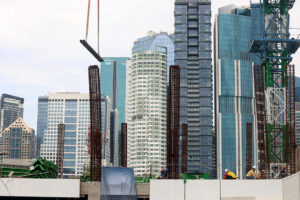Starting this week, civil aviation authorities began charging airline companies and passengers around 60% more for using the country’s airports. Under Memorandum Circular 019-2025, the Civil Aviation Authority of the Philippines (CAAP) raised the passenger service charge (PSC), or terminal fee, for international flights to P900 from P550.
For domestic flights, the terminal fee is now P350 for passengers departing from international airports; P300 for “principal class 1” airports; P200 for “principal class 2” airports; and P100 for “community airports.” Pre-viously, all domestic passengers paid a flat terminal fee of P200.
Aside from terminal fees, CAAP also increased landing and take-off fees for all international and domestic flights, as well as charges for the use of various airport facilities. These include runways, taxiways, apron areas, parking (based on aircraft weight and number of hours), lighting systems for landings and takeoffs from 6 p.m. to 6 a.m., and the use of boarding bridges or passenger tubes.
Offhand, the hike appears justified. CAAP noted that fees were last revised a decade ago and required adjustment to reflect inflation from 2015 to the present. The new rates apply only to CAAP-operated airports. According to CAAP, the fee hike “supports CAAP’s efforts to enhance passenger experience and improve airport facilities and operations.”
Privately operated airports — such as the Ninoy Aquino International Airport (NAIA), the Mactan-Cebu International Airport, Clark International Airport, and Caticlan Airport in Boracay — are not covered by the new CAAP terminal fee schedule. These operators set their own terminal fees independently.
At NAIA, terminal fees are expected to increase by September to P950 for international departures and P390 for domestic flights. However, CAAP’s revised airport charges — such as those for takeoff and landing — will still apply. In gen-eral, it appears that air travel is about to become more expensive for both airlines and passengers.
Admittedly, inflation has eroded the real value of CAAP’s fees over the past decade. Operating airports requires ongoing capital outlays for maintenance, equipment upgrades, and modernization. Still, I believe that instead of an outright fee hike, a calibrated, transparent, and consultative approach would have been more appropriate.
CAAP’s financial track record since 2018 — and comparisons with other ASEAN aviation authorities — suggest that the increase, both in magnitude and timing, may be premature and not entirely aligned with the goal of fostering long-term industry sustainability.
Consider CAAP’s audited financial records. As a government-owned and -controlled corporation (GOCC), CAAP remained profitable for most of the last decade, even without raising fees. In 2017 and 2018, its net in-come exceeded P2 billion annually. While operations were disrupted by the COVID-19 pandemic in 2020 and 2021, CAAP quickly recovered. It posted a P1.97 billion net income in 2022, followed by P2.18 billion in 2023. In short, CAAP is back to pre-pandemic profitability — without needing to increase fees.
To its credit, CAAP has managed to balance revenues and expenses while operating more than 80 airports across the country. Given this, I believe the 60% jump now in international terminal fees is disproportionate. CAAP’s own financial statements suggest it can continue operating profitably even under the current fee structure.
Moreover, any fee increase should not be based solely on inflation. Instead, fees should be tied directly to specific, measurable improvements in airport infrastructure, technology, safety systems, and passenger experience. In short: why should passengers and airline companies pay 60% more starting this month if services and facilities do not improve by at least that much?
At this point, I am uncertain which projects will be funded by the additional collections, how much they will cost, or where they will be implemented. CAAP should publish a list of priority projects, including timelines and projected budgets — for example, navigational aid modernization, terminal expansions, and airside safety improvements. It should inform the public what to expect in exchange for higher fees.
The worrying outcome would be if these additional collections simply go toward general operations, including salaries and administrative costs, without any visible or tangible improvements in airport services or operational efficiency. All this for the sake of improving profitability? But to whose benefit? Only CAAP’s? What will the flying public gain in return?
There’s also the matter of regional comparisons. At P900, the new international passenger terminal fee at CAAP airports is going to be slightly higher than those of several neighboring ASEAN countries. Malaysia charges about P740, Thailand around P800, with Vietnam and Indonesia reportedly maintaining comparable or lower rates. But are Philippine airports better than their counterparts in these countries? Will they become better in two to three years? Any increase in fees must be matched by actual improvements in service quality.
Granted, the new fee structure is already in place. But perhaps CAAP can still recalibrate. I believe a staggered implementation would have been better. Instead of a one-time 60% hike, CAAP could have pursued a three-year phased approach: a 15%-20% increase annually from 2025 to 2027. This would allow both airlines and passengers more time to adjust.
Gradual fee adjustments are easier to justify — and accept — when they are accompanied by incremental, visible improvements. This approach would also give CAAP more flexibility to roll out and fund its projects, while managing stakeholder expectations.
Transparency and accountability are paramount. As a government corporation generating revenue in exchange for public services, CAAP should reinvest every extra peso it collects toward improving those services. CAAP is not a revenue collection agency; its authority to impose fees is grounded in its public service mandate.
Over the last 10 years, CAAP has demonstrated that it can manage its resources well. Its personnel have shown they can run the agency profitably even under the current fee regime, despite inflation. The next challenge is for CAAP to demonstrate that it can also fulfill its mandate effectively by using its P2 billion-plus annual profits to enhance airport services.
A sudden, across-the-board fee hike of up to 60% should be reconsidered. A phased, transparent, and performance-based approach makes more sense — for passengers, airlines, and for CAAP itself. CAAP should have tangi-ble, measurable projects that actually “enhance passenger experience and improve airport facilities and operations.”
Marvin Tort is a former managing editor of BusinessWorld, and a former chairman of the Philippine Press Council






